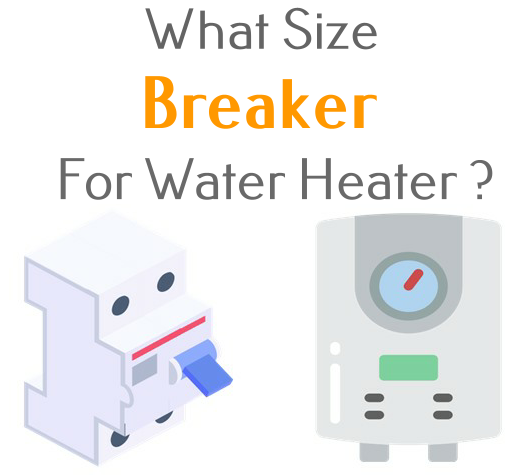The majority of homes include standard devices like water heaters. However, the water entering your house is often chilly or hot, depending on the season. It would help if you had a water heater to have warm enough water to wash your clothes, take a bath, or shower.
One might wonder, what size breaker for a water heater? Before that, they usually resided in a utility room or basement, resembling large metal cylinders. However, tankless water heaters offer limitless hot water on demand and are noteworthy aspects of more recent types.
What Size Breaker for Water Heater?
A 240-volt dedicated circuit solely powers the water heater; no other electronics are necessary for electric water heaters. In circuit wiring, non-metallic (NM) or MC wires of 10-2 size are commonly used with 30 amp breakers for water heaters.

The white circuit wire is connected to the red or white wire lead on the water heater, while the black circuit wire is connected to the black wire lead on the water heater breaker.
The white circuit wire has to be marked as a “hot” wire, not a neutral wire, by wrapping it in black or red electrical tape close to the connection at both ends of the circuit (at the water heater and the breaker box).
A 240-volt circuit transmits live electricity in black and white wires, unlike typical 120-volt circuits. The green ground screw on the water heater or, if present, the ground lead on the water heater is where the circuit ground wire is connected.
How Do Electric Water Heaters Work?
The operation of an electric water heater, which often has heating elements of around 4500 watts, is quite similar to that of a gas water heater. These heating elements are responsible for warming the water to the desired temperature.
The dip tube draws in cold water, then heated within the tank by electric heating components. Finally, it is dispersed throughout the house through the heat-out pipe in the tank.
Anode rods, temperature, pressure relief valves, drain valves, insulated tanks, and thermostats are all features of electric water heaters, just like their gas counterparts. Electric components heat the water. Thus it is hooked into a power source, which is the only significant difference.
A home warranty plan will cover a breaker for the electric water heater if it breaks down due to regular wear and tear.
Understanding the relationship between the wattage and voltage of your water heater and the size of the breaker is key. For example, a water heater with a higher wattage, such as 4500 watts, will require a larger breaker than a lower-wattage unit. This ensures that the breaker can adequately handle the electrical load without frequently tripping.
A 5-Step Guide to Fixing an Electrical Water Heaters
- Check Out the Other Appliances
Look at the circuit breaker and see which other appliances are connected to the same circuit as the water heater. A circuit breaker may trip because of plugged-in appliances in nearby outlets, or someone could have switched it off without your knowledge.
- The Thermostat May be Malfunctioning
Electrical water heaters may unintentionally begin heating both elements at once if the thermostat becomes locked in the on position. It may result in high power consumption on the electrical circuit, tripping the circuit breaker. Most water heaters contain a limit control that keeps the water from getting hotter than 180 degrees.
Read also: How to Test Water Heater Element
- Element Failure in a Heating System
The heating element can short-circuit if the heating element’s shell starts to fracture. If your water heater has two distinct heating components, inspect each to ensure proper operation. You must also examine the heating components if the abovementioned thermostat issue persists.
- Make Sure There are No Leaks in Water
Many outdated 50-gal water heater breaker sizes tend to leak. In that instance, water could start gravitating toward all the electrical components. If there is standing water close to the water heater, it could come into contact with an electrical component. This can shorten the entire system and result in severe electrical shock.
- See How It’s Wired Internally
You need to pay attention to more than just the size of the breaker on a water heater. First, turn off the circuit breaker and disconnect the electricity before attempting any work on the water heater’s internal wiring. You also might wish to hire an electrician for assistance with this step if you are not an electrician.
When equipped with the correct information, such as the wattage and voltage requirements of your water heater, determining what size breaker for water heater becomes straightforward. For instance, a typical 4500-watt heater operating on a 240-volt supply would draw about 18.75 amps, necessitating a breaker that can handle at least this current.
It’s important to note that the type of breaker used is also crucial. For most residential electric water heaters, a double-pole breaker is recommended. This type of breaker ensures that the hot wires connected to the water heater are simultaneously disconnected in case of an overload, providing an extra layer of safety.


